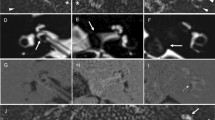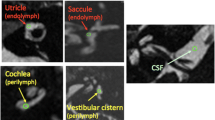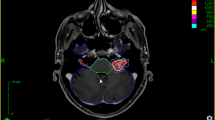Abstract
Introduction
In the vestibular schwannoma patients, the pathophysiologic mechanism of inner ear involvement is still unclear. We investigated the status of the cochleae in patients with vestibular schwannoma by evaluating the signal intensity of cochlear fluid on pre- and post-contrast enhanced thin section three-dimensional fluid-attenuated inversion recovery (3D-FLAIR).
Methods
Twenty-eight patients were retrospectively analyzed. Post-contrast images were obtained in 18 patients, and 20 patients had the records of their pure-tone audiometry. Regions of interest of both cochleae (C) and of the medulla oblongata (M) were determined on 3D-FLAIR images by referring to 3D heavily T2-weighted images on a workstation. The signal intensity ratio between C and M on the 3D-FLAIR images (CM ratio) was then evaluated. In addition, correlation between the CM ratio and the hearing level was also evaluated.
Results
The CM ratio of the affected side was significantly higher than that of the unaffected side (p < 0.001). In the affected side, post-contrast signal elevation was observed (p < 0.005). In 13 patients (26 cochleae) who underwent both gadolinium injection and the pure-tone audiometry, the post-contrast CM ratio correlated with hearing level (p < 0.05).
Conclusion
The results of the present study suggest that alteration of cochlear fluid composition and increased permeability of the blood–labyrinthine barrier exist in the affected side in patients with vestibular schwannoma. Furthermore, although weak, positive correlation between post-contrast cochlear signal intensity on 3D-FLAIR and hearing level warrants further study to clarify the relationship between 3D-FLAIR findings and prognosis of hearing preservation surgery.




Similar content being viewed by others
References
Silverstein H, Schuknecht HF (1966) Biochemical studies of inner ear fluid in man: changes in otosclerosis, Meniere's disease, and acoustic neuroma. Arch Otolaryngol 84:395–402
Silverstein H (1971) Inner ear fluid proteins in acoustic neuroma, Meniere's disease, and otosclerosis. Ann Otol Rhinol Laryngol 80:27–35
Silverstein H (1973) Labyrinthine tap as a diagnostic test for acoustic neuroma. Otolaryngol Clin North Am 6:229–244
Silverstein H, Naufal P, Belal A (1973) Causes of elevated perilymph protein concentrations. Laryngoscope 83:476–487
Melhem ER, Jara H, Eustace S (1997) Fluid-attenuated inversion recovery MR imaging: identification of protein concentration threshold for CSF hyperintensity. AJR Am J Roentgenol 169:859–862
Mishra AM, Reddy SJ, Husain M, Behari S, Husain N, Prasad KN, Kumar S, Gupta RK (2006) Comparison of the magnetization transfer ratio and fluid-attenuated inversion recovery imaging signal intensity in differentiation of various cystic intracranial mass lesions and its correlation with biological parameters. J Magn Reson Imaging 24:52–56
Naganawa S, Koshikawa T, Nakamura T, Kawai H, Fukatsu H, Ishigaki T, Komada T, Maruyama K, Takizawa O (2004) Comparison of flow artifacts between 2D-FLAIR and 3D-FLAIR sequences at 3T. Eur Radiol 14:1901–1908
Sugiura M, Naganawa S, Sato E, Nakashima T (2006) Visualization of a high protein concentration in the cochlea of a patient with a large endolymphatic duct and sac, using three-dimensional fluid-attenuated inversion recovery magnetic resonance imaging. J Laryngol Otol 120:1084–1086
Sugiura M, Naganawa S, Teranishi M, Sato E, Kojima S, Nakashima T (2006) Inner ear hemorrhage in systemic lupus erythematosus. Laryngoscope 116:826–828
Otake H, Sugiura M, Naganawa S, Nakashima T (2006) 3D-FLAIR magnetic resonance imaging in the evaluation of mumps deafness. Int J Pediatr Otorhinolaryngol 70:2115–2117
Sugiura M, Naganawa S, Teranishi M, Nakashima T (2006) Three-dimensional fluid-attenuated inversion recovery magnetic resonance imaging findings in patients with sudden sensorineural hearing loss. Laryngoscope 116:1451–1454
Sone M, Mizuno T, Sugiura M, Naganawa S, Nakashima T (2007) Three-dimensional fluid-attenuated inversion recovery magnetic resonance imaging investigation of inner ear disturbances in cases of middle ear cholesteatoma with labyrinthine fistula. Otol Neurotol 28:1029–1033
Sugiura M, Naganawa S, Sone M, Yoshida T, Nakashima T (2008) Three-dimensional fluid attenuated inversion recovery magnetic resonance imaging findings in a patient with cochlear otosclerosis. Auris Nasus Larynx 35:269–272
Committee on Hearing and Equilibrium, American Academy of Otolaryngology-Head and Neck Surgery (1995) Committee on hearing and equilibrium guidelines for the evaluation of hearing preservation in acoustic neuroma (vestibular schwannoma). Otolaryngol Head Neck Surg 113:179–180
Eckermeier L, Pirsig W, Mueller D (1979) Histopathology of 30 non-operated acoustic schwannomas. Arch otorhinolaryngol 222:1–9
O'Connor AF, France MW, Morrison AW (1981) Perilymph total protein levels associated with cerebellopontine angle lesions. Am J Otol 2:193–195
Thomsen J, Saxtrup O, Tos M (1982) Quantitated determination of proteins in perilymph in patients with acoustic neuroma. ORL J Otorhinolaryngol Relat Spec 44:61–65
Naganawa S, Komada T, Fukatsu H, Ishigaki T, Takizawa O (2006) Observation of contrast enhancement in the cochlear fluid space of healthy subjects using a 3D-FLAIR sequence at 3 Tesla. Eur Radiol 16:733–737
Mathews VP, Caldemeyer KS, Lowe MJ, Greenspan SL, Weber DM, Ulmer JL (1999) Brain: gadolinium-enhanced fast fluid-attenuated inversion-recovery MR imaging. Radiology 211:257–263
Jackson EF, Hayman LA (2000) Meningeal enhancement on fast FLAIR images. Radiology 215:922–924
Kastenbauer S, Klein M, Koedel U, Pfister HW (2001) Reactive nitrogen species contribute to blood–labyrinth barrier disruption in suppurative labyrinthitis complicating experimental pneumococcal meningitis in the rat. Brain res 904:208–217
Nakashima T, Naganawa S, Sone M, Tominaga M, Hayashi H, Yamamoto H, Liu X, Nuttall AL (2003) Disorders of cochlear blood flow. Brain Res Brain Res Rev 43:17–28
Naganawa S, Sugiura M, Kawamura M, Fukatsu H, Nakashima T, Maruyama K (2006) Prompt contrast enhancement of cerebrospinal fluid space in the fundus of the internal auditory canal: observations in patients with meningeal diseases on 3D-FLAIR images at 3 Tesla. Magn Reson Med Sci 5:151–155
O'Connor AF, Luxon LM, Shortman RC, Thompson EJ, Morrison AW (1982) Electrophoretic separation and identification of perilymph proteins in cases of acoustic neuroma. Acta Otolaryngol 93:195–200
Palva T, Raunio V (1982) Cerebrospinal fluid and acoustic neuroma specific proteins in perilymph. Acta Otolaryngol 93:201–203
Rasmussen N, Bendtzen K, Thomsen J, Tos M (1983) Specific cellular immunity in acoustic neuroma patients. Otolaryngol Head Neck Surg 91:532–536
Rasmussen N, Bendtzen K, Thomsen J, Tos M (1984) Antigenicity and protein content of perilymph in acoustic neuroma patients. Acta Otolaryngol 97:502–508
Yoshida T, Sugiura M, Naganawa S, Teranishi M, Nakata S, Nakashima T (2008) Three-dimensional fluid-attenuated inversion recovery magnetic resonance imaging findings and prognosis in sudden sensorineural hearing loss. Laryngoscope 118:1433–1437
Gussen R (1976) Sudden deafness of vascular origin: a human temporal bone study. Ann Otol Rhinol Laryngol 85:94–100
Fitzgerald DC, Mark AS (1999) Viral cochleitis with gadolinium enhancement of the cochlea on magnetic resonance imaging scan. Otolaryngol Head Neck Surg 121:130–132
Barker GJ (1998) 3D fast FLAIR: a CSF-nulled 3D fast spin-echo pulse sequence. Magn Reson Imaging 16:715–720
Naganawa S, Kawai H, Fukatsu H, Ishigaki T, Komada T, Maruyama K, Takizawa O (2004) High-speed imaging at 3 Tesla: a technical and clinical review with an emphasis on whole-brain 3D imaging. Magn Reson Med Sci 3:177–187
Haacke EM, Frahm J (1991) A guide to understanding key aspects of fast gradient-echo imaging. J Magn Reson Imaging 1:621–624
Somers T, Casselman J, de Ceulaer G, Govaerts P, Offeciers E (2001) Prognostic value of magnetic resonance imaging findings in hearing preservation surgery for vestibular schwannoma. Otol Neurotol 22:87–94
Naganawa S, Satake H, Kawamura M, Fukatsu H, Sone M, Nakashima T (2008) Separate visualization of endolymphatic space, perilymphatic space and bone by a single pulse sequence; 3D-inversion recovery imaging utilizing real reconstruction after intratympanic Gd-DTPA administration at 3 Tesla. Eur Radiol 18:920–924
Naganawa S, Satake H, Iwano S, Fukatsu H, Sone M, Nakashima T (2008) Imaging endolymphatic hydrops at 3 Tesla using 3D-FLAIR with intratympanic Gd-DTPA administration. Magn Reson Med Sci 7:85–91
Naganawa S, Koshikawa T, Fukatsu H, Ishigaki T, Fukuta T (2001) MR cisternography of the cerebellopontine angle: comparison of three-dimensional fast asymmetrical spin-echo and three-dimensional constructive interference in the steady-state sequences. AJNR Am J Neuroradiol 22:1179–1185
Bhadelia RA, Tedesco KL, Hwang S, Erbay SH, Lee PH, Shao W, Heilman C (2008) Increased cochlear fluid-attenuated inversion recovery signal in patients with vestibular schwannoma. AJNR Am J Neuroradiol 29:720–723
Conflict of interest statement
We declare that we have no conflict of interest.
Author information
Authors and Affiliations
Corresponding author
Rights and permissions
About this article
Cite this article
Yamazaki, M., Naganawa, S., Kawai, H. et al. Increased signal intensity of the cochlea on pre- and post-contrast enhanced 3D-FLAIR in patients with vestibular schwannoma. Neuroradiology 51, 855–863 (2009). https://doi.org/10.1007/s00234-009-0588-6
Received:
Accepted:
Published:
Issue Date:
DOI: https://doi.org/10.1007/s00234-009-0588-6




